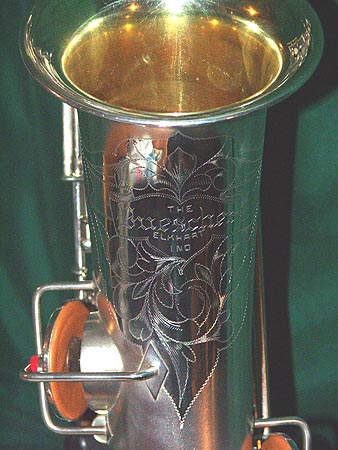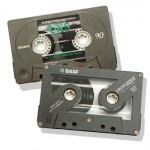For some time I’ve been thinking of buying a saxophone. A few years back I had the same urge to buy a clarinet (I ended up with 3 of them) and I’ve enjoyed learning to play that silly thing. Time to bite the bullet and find a sax.
If you’re like me, and I know I am, you enjoy finding good prices on things. I’ve a collection of crap I want to buy and I scan through paper ads, pawn shops, craigslist.org, and from time to time I slum on ebay. One day on craigslist an entry for an old 1922 silver Buescher C-Melody saxophone shows up.
I bet you’re asking “What the hell is a C-Melody Saxophone?”
I’m not going to go into the complete history of the C-Melody (google is your friend) but basically it is a Tenor Sax in C instead of Bb. Most of these horns were made in the 1920�s.
If I recall, the advert on Craigslist was asking $300 for the horn. There was a picture or two and it looked ok. The advert said “playable”. I sent an email and went back and forth with the seller and finally managed to meet up with her.
The horn was NOT playable.
Firstly, the horn was covered in black and brown goo. Most of the keys were sticky. 50% of the pads were shot. At this point I’ve never even played a saxophone let alone be a sax repair wiz-kid. But I could tell it would need some work. I made an offer ($200 I think) and the deal was made. For the price I received the horn, neck, the original case (which is in pretty good shape), a beat up rusty ligature and a C-Melody mouthpiece.
Now what? I’ve never taken apart a sax. I have no idea how to replace pads. I wasn’t even sure what products to use to remove the layers of crap. I hit up google.com and did some research for a few days.
The first thing I find out is C-Melody horns use what is called a “snap-in pad”. Instead of gluing the pad in place there is a resonator that acts as a snap to hold the pad in. Snap-in pads have metal backs, a larger hole in the middle for a post to snap the resonator onto, and are just basically different from everyday sax pads. I found a place called MusicMedic.com which sells new C-Mel pads in various sizes. They also sell corks, oils, and pretty much anything a budding sax tech would want.
At first glance the parts of a saxophone look pretty damn complex. Keys, tubes, posts and pad cups going every which way. I had this vision of me with my tail between my legs walking into a repair shop with a gutted horn in one hand and a bagful of sax parts in the other. I decided to play it safe.
I dug around online and found pictures of the same model sax. I printed out various shots of the key assemblies to use as a guide in putting the thing back together. I decided I would remove one assembly at a time, removing the pads and cleaning the area around that section – then reassemble and move to the next section. This way it would be easier to keep track of the parts. I also decided to start with the bell section (which is by far simpler) and work my way up the horn to the neck.
Most of the pads were shot. From what I could tell they were the original pads that came with the horn. White leather with metal backs stamped “1921”. In some cases the metal had corroded and fixed itself to the inside of the cup. When I finally got the pad off the entire back of the metal was a fine gray powder.
I cleaned the silver using a soft toothbrush and silver paste. As I’m cleaning I learn the body of the horn has a matte finish while all the key assemblies and cups are high polish. I also learn the inside of the bell has a gold wash to it. After the gunk was off and the tarnish removed I either hand rubbed the high polish areas or used a felt round on a Dremmel. I was careful to not go through the silver as I didn’t know what was under it.
As I’m cleaning I noticed something inside the horn. At first I thought it was some sort of support inside the body but then realized it was in front of one of the pads about 3 inches up from the thumb rest. I managed to work it free and out pops the original silver C-Melody ligature in near perfect shape. It’s even got a “C” stamped on the front of it.
Some of the springs, screws and rods were rusted. I took a wire wheel Dremmel bit to these and they cleaned up nicely. Most of the key assemblies had layers of black gunk which I later figured out was old key oil. Simple Green to the rescue!
It took some time but after a couple of weekends I managed to disassemble, clean and reassemble the entire horn.
I still have to put on the pads, seat them and cut new corks and felts. I decided to do this after the horn was fully cleaned so I could rinse the lot off under the tap. Once I start putting leather pads on this becomes a bad idea.
As I learned from my old metal Regent clarinet, a leaky pad is a squeaky horn. The tech that worked on my Regent clarinet showed me a trick on how to seal pads – drop a light down the horn. When you finger the pad closed you should see no light around it. Hmmm? Sounds easy.
I begin to repad the horn starting at the bell. This went pretty well. Some of the cups I didn’t even remove because of the snap-in pads. Once I got all the pads on I was itching to play it. I expected the worse and that’s what I got. Honk-squeeeeek! Because most the pads didn’t seal I would only play the top few notes. Of 24 or so pads I think only two sealed.
I managed to seat a few pads with a simple use of force. I placed a chopstick under some of pads and used small amounts of pressure to torque the cups in the right direction. A little at a time I managed to seat half the pads. Some pads still wouldn’t seal.
I’ve been talking with another tech (who, by the way, tried to talk me out of refurbishing this sax) said I should glue the pads in place because seating them is much easier. I told him I might but I wanted to first see the horn as it was meant to be. He gave me a tip. If the snap in pad doesn’t seat flat, cut some card stock and place it behind the side of the pad that is leaking. This worked like a charm. I cut card stock in various half moon shapes and used a tiny touch of glue to hold the paper in place.
At the same time I started on the corks. At first I thought the corks were just padding to stop metal bits from clunking on each other. I soon learn the cork also is used to hold keys in position and provide better action. I spent about 6 hours in all cutting corks, seating pads, sanding down corks, re-seating pads, and re-cutting cork after I sanded too much off. After the first 4 hours of this I started to get the hang of it. The last two hours were mostly doing the first bits over again.
Next was the neck cork. I expected this to go fairly easy. Boy was I wrong. Of the entire horn restoration I think I goofed this best of all. After several terrible attempts I decided to have someone else do this bit. $10 bucks later I had a new neck cork.
And now, the C-Melody is restored.















Recent Comments